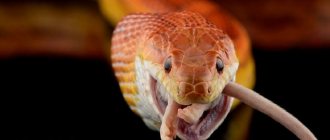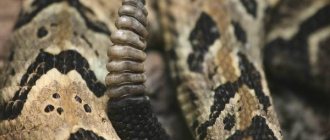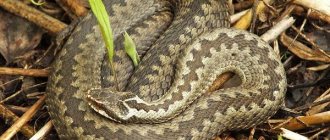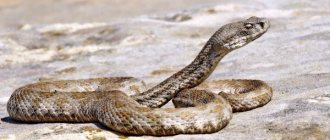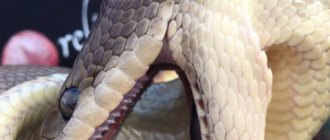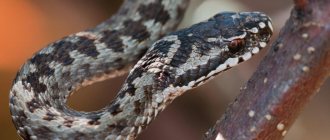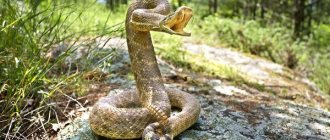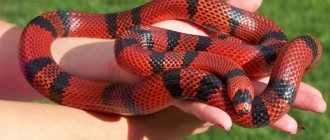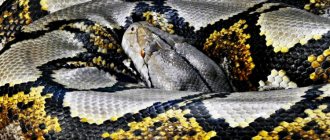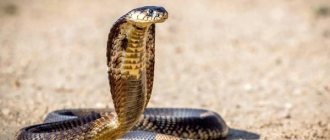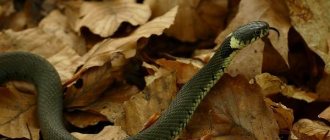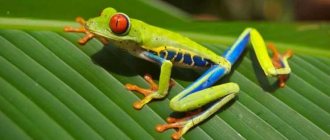An interesting creature lives on Earth called the sand ephas (Echis carinatus) and it belongs to the snakes, although it stands out even among its cold-blooded relatives: it reproduces in its own way and moves in an original way. It’s interesting to learn some interesting facts about this snake, but it’s unlikely that you’ll be able to make friends with it.
Description
Sand ephs are representatives of the viper family, and these snakes are recognized not only as the most poisonous reptiles in nature, but also as the crown of evolution among this order. The small efa, despite its bewitching and harmless appearance and fairly calm character, is capable of poisoning an enemy in just a few moments: it takes its rightful place in the top ten most poisonous snakes. Its poison is so strong that even timely administration of the serum will not protect you from health problems for the rest of your life.
This poison can cause unstoppable bleeding at the site of the bite, which is accompanied by bleeding from the mucous membranes of the mouth and eyes, as well as hemorrhage into the internal organs. According to statistics, at least 20% of all victims die from the bite of the sand ephas, while the rest can be saved by administering the serum.
The sand epha is a medium-sized reptile - up to a maximum of 76 cm in length - twice as small as the same cobra or viper. One of the identifying features of this species is a zigzag light stripe along the length of the entire body. There must be white spots (back and head) - and the brightness of the spots differs in different subspecies of this snake.
The scales of these reptiles are small, with quite noticeable protruding ribs in the back area. On the sides, the snake’s body is equipped with several rows (up to five) of small scales directed diagonally downward, which are framed by jagged ribs. These scales serve as a kind of musical accompaniment, thanks to which the snake creates a certain warning signal, similar to a hissing rustling sound.
Unlike other snakes, the sand epha moves on quick sand differently than all reptiles, i.e. wave-like, but in a lateral motion, which is accompanied by sharp throws of the body in a certain direction. It looks memorable and unusual: the snake first throws its head away, then sharply pulls the back part of its body towards it, and only then the front part follows. As a result of this unusual method of movement, a clear trace of oblique stripes with curled ends can be found on the sand.
Natural enemies of efa
Photo: What the efa snake looks like
Due to its excessive resourcefulness, the efa has very few enemies in nature. Many still call the main enemy a person who seeks to exterminate a population that is potentially dangerous to himself. But in fact, in natural conditions, efu also faces dangers. In particular, sometimes the ef can be attacked by monitor lizards and stronger, larger snakes (for example, cobras).
Interesting fact: Rare cases of ephas eating each other are known.
In normal times, it is quite easy for a snake to simply run away or give a worthy rebuff to the enemy. But at times when there are significant drops in temperatures, Ephs become more lethargic and can no longer react properly to aggression. At this time, owls can pose a danger to them, and in the case of crossing with magpies, they too. Birds deliver targeted blows with their beaks to the head or liver area. However, they never completely peck the snake. There are also cases where birds simply bit off a snake's tail.
For exhausted or very young snakes, wasps and ants pose a particular danger. They can attack the snake, biting through the skin and causing, albeit small, but serious wounds. When the snake is too weak, they attack in large numbers, first of all penetrating into the mouth and eyes of the reptile. Ultimately, the ants are able to gnaw the snake so much that only a skeleton remains. In nature, the mole vole can also cause significant harm. It often clogs the opening of the hole in which the snake is located. As a result, the reptile simply suffocates.
Interesting fact: If danger approaches the efa, it can hide so quickly in the sand that it seems as if it is drowning in it.
It is worth noting that recently they often prefer to keep the eph in captivity, having previously deprived it of its deadly poison. Under these conditions, ordinary cats pose a danger to this type of snake. They can easily hit the snake on the head with their paw and then bite its neck.
Appearance
Sand ephs are small snakes and rarely exceed one meter in length. The males of this species of reptiles are more impressive in size than the females. The bright color of these snakes (yellow or golden), accompanied by a pattern of two zigzag lines along the body and light head spots, forming a peculiar pattern in the form of a cross or a soaring bird, are the characteristics that define this species. In general, these reptiles have a very elegant appearance.
These reptiles have huge round eyes: and the color of the iris of the eyes usually coincides with the general coloring of the sand ephas. The snake’s belly is usually a light yellow hue, but the scales themselves can be varied - its color depends, to a greater extent, on the area where the efa lives: from golden to dark brown.
The body of the sand epha is covered with scales - tiny and rough to the touch, and some of them are designed to alert others to the appearance of this formidable enemy - due to the fact that they grow in the opposite direction, they are capable of creating an absolutely specific sound, similar to rustling.
Synonyms
- Pseudoboa Carinata
- Schneider, 1801 - Boa Horatta
- Shaw, 1802 - Scytale bizonatus
- Daudin, 1803 - Vipera
(
Echis
)
carinata
- Merrem, 1820 - Echis zic zac
- Gray, 1825 - Boa horatta
- Gray, 1825 - Echis carinata
- Wagler, 1830 - Vipera echis
- Schlegel, 1837 - Echis
(
Echis
)
carinata
- Gray, 1849 - Echis ziczic
- Gray, 1849 - Vipera noratta
- Jerdon, 1854 - Vipera
(
Echis
)
carinata
- Jan, 1859 - Vipera
(
Echis
)
superciliosa
- Jan, 1859 - Echis superciliosa
- Jan, 1863 - Vipera Echis Carinata
- Higgins, 1873 - Echis carinatus
- Boulenger, 1896 - Echis carinata
var.
nigrosincta
- Ingoldby, 1923 - Echis carinatus carinatus
- Constable, 1949 - Echis carinatus
- Mertens, 1969 - Echis carinatus
- Latifi, 1978 - Echis
(
Echis
)
carinatus carinatus
- Cherlin, 1990 - Echis carinata carinata
- Das, 1996[8]
Where does it live?
Close relatives of sand ephemerals are common vipers. They live in wetter places, and efa chose rather dry and hot territories as their habitat: deserts (Tajikistan, Uzbekistan, Turkmenistan), sandy territories in northern Africa, and southern Asia, ranging from the Arabian Peninsula to the foothills and valleys of Iraq, Afghanistan and some areas of Hindustan (here ephs are found in incredible numbers). That is, it can be found in almost all areas that belong to the Asian part of Eurasia.
Efa prefers to lead a reclusive existence, and they try with all their might to avoid meeting people. And practice shows that the vast majority of all bites of this snake are the result of human negligence: the victim either steps on the snake or destroys its nest, regardless of the intentionality of such an act.
At the same time, the efa does not have problems with shelter. These are either thickets, or cracks, or holes. But the sandy efa gives preference to sandy areas where shrubs and grass are present. Efa also feels great on rocky surfaces.
The sand efu can be called the only representative of this genus that could be found on the territory of the former USSR. A subspecies of this genus, the Central Asian efa, lives in Turkmenistan, Uzbekistan and in some areas of Tajikistan. Sometimes Echis carinatus multisquamatus is classified by some biologists as a separate species of reptile.
Habitat
Ephs are found in arid climates - there are many of them in the vast deserts and wastelands of Africa. Some subspecies live in Indonesia and southern Asia. They are also found on the territory of Uzbekistan and Turkmenistan. Despite the fact that in these countries the populations of ephemeral snakes are not as large as in other areas, the snakes still pose a serious danger to people.
Ephs rarely stay for long in their favorite territories, migrating either to deserts or to steppe areas densely overgrown with vegetation. Some representatives prefer rocky terrain. Due to their small size, these reptiles easily slip even into narrow crevices. But nevertheless, this is precisely why the photos of the Efa snake were taken in different natural conditions. The snake spends most of its life in bushes:
- firstly, she prefers to be invisible to prying eyes,
- secondly, wooded areas are much richer in food.
Lifestyle
Unlike all their relatives, sand ephs have a high level of activity. Efa is a fairly mobile reptile; they spend most of their life in motion, not stopping even at the moment of digesting food.
But sometimes, especially in early spring, these snakes like to lie down and bask in the sun, like any reptile. With the onset of winter cold, many snakes hibernate, but not the sand epha. This snake continues to lead an active life, and even its mating period can occur in the middle of winter (sometimes even in January). The only condition for this is an acceptable ambient temperature.
In spring and autumn, these snakes prefer a daytime activity, but in the summer, when it’s hot, they switch to a nocturnal lifestyle. Their wintering usually begins in mid-autumn - and for this, ephs look for a suitable shelter. And on warm days they can often be found basking in the sun.
The main and overwhelming part of the diet of these reptiles consists of a variety of insects: from grasshoppers to beetles and locusts. But adults are not against eating small mammals - rodents, birds and reptiles. Young snakes that have not yet acquired the necessary dexterity are usually content with insects and small lizards.
What does the efa snake eat?
Photo: Poisonous snake efa
The efa spends most of its time in motion. Even after a hearty lunch, she doesn't slow down. That is why it is especially easy for her to get food. She can easily move sufficient distances and find a tasty diet for herself in a new place. In addition, due to its amazing speed, catching prey is usually not difficult.
Efa can eat the food that it manages to catch. Bugs, centipedes, locusts and other insects form the basis of Efa's diet. But this only applies to young individuals and small snakes. Adults most often still prefer rodents and even chicks, small-sized lizards. This provides them with much longer satiety and eliminates the need to look for food.
Usually snakes prefer to hunt at night. This is especially true on hot summer days. Then the efa waits out the heat in the hole, and at night goes out to hunt. Since snakes see well in the dark, it is not difficult to perfectly navigate the terrain in search of prey. But the rest of the time, the efa can lead an equally active lifestyle at any time, without giving up hunting even during the daytime.
Small-sized prey can be swallowed whole by a snake, which is most convenient for it. But if the potential victim is very large or can offer resistance, then the snake first immobilizes it with a portion of poison, and only then eats it. At night, the efa most often prefers to hunt mice and other small rodents.
Interesting fact: Efa is so dangerous that it can even hunt scorpions without difficulty.
Reproduction
Mating games of this species of reptiles begin in winter, and the mating period can start already in the middle of winter. The breeding season of these snakes occurs at the beginning of spring - and lasts for a month.
Unlike other species of reptiles, ephas are viviparous snakes, which is their distinctive feature. The female brings babies at the beginning of summer, and the litter contains from three to 16 cubs, which are no more than 15 cm long.
Titles
In India it is called [3]: Oriya rana
, Hindi
afai
, Malayalam.
churuta
or
anali
, guj.
tarachha
or
zeri padkoo udaneyn
, cann.
kallu have
, Marathi.
phoorsa
, Sindhi
kuppur
or
janndi
, Tagalog.
surattai pambu
[4] or
viriyan pamboo
or
surutai vireyan
.
In Sri Lanka - Sinhalese. vali polonga
[4].
In Uzbekistan - Uzbek. charkh iyylon - “noisy snake”[5].
In Afghanistan and Pakistan - Pashto phissi
[3].
In the USA - English. saw-scaled viper
[6],
Indian saw-scaled viper
,
little Indian viper
[7].
Interesting Facts
The bite of the sand epha is extremely dangerous, and most attacks by this snake result in death. The dose of a toxic substance that can cause death is 5 mg. Efu cannot be called the most poisonous snake. It is only in seventh place, but based on statistics, we can conclude that every seventh person who died from a snake bite on Earth died precisely from the bite of this type of reptile. And every fifth person dies from the bite of this dangerous snake.
Its venom contains extremely powerful toxins; they have a specific effect on the entire blood-forming process in the human body. Because of them, the level of fibrinogen, a protein that is responsible for the coagulation rate, very sharply decreases, which means that the victim simply bleeds to death.
This snake is not afraid of humans, and can often be found in homes or utility rooms, where it crawls in search of food. There are known cases when these snakes settled simply under the floor in the house. Ephs are extremely dangerous, as a rule, during the period of mating and courtship games.
The sand epha is not only active, it is capable of jumping to a height of over a meter, and no less than three meters in length. And if we are talking about an angry female with cubs, then she will attack with lightning speed and without warning.
Activity and mobility, combined with the speed of which efa is capable, can make a lasting impression. Before attacking, the snake begins to wriggle in a specific way, forming two bends from its body and holding its head in an attack position directly between them. At the same time, the epha is spinning all the time, and does not remain calm for a moment.
Green mamba
This incredibly beautiful reptile lives in Africa. If you scare a green mamba, this snake becomes very aggressive. This member of the adder family is capable of killing its prey using a venom that contains fast-acting neurotoxins. Neurotoxins can cause systemic paralysis and tissue necrosis. After two hours, the person’s lungs fail. A person bitten by a green mamba urgently needs to be given an antidote.
Notes
- Ananyeva N. B., Borkin L. Ya., Darevsky I. S., Orlov N. L.
Five-language dictionary of animal names. Amphibians and reptiles. Latin, Russian, English, German, French. / under the general editorship of academician. V. E. Sokolova. - M.: Rus. lang., 1988. - P. 362. - 10,500 copies. — ISBN 5-200-00232-X. - [big-snake.org/enc/raznoe/top10_venomous_snake.htm The most poisonous snakes in the world]
- ↑ 12
Daniels, J.C. (2002) The Book of Indian Reptiles and Amphibians, BNHS & Oxford University Press, Mumbai, pp. 151-153. ISBN 0-19-566099-4 (English) - ↑ 12
[www.slwcs.org/facts/snakes.html Checklists of the Snakes of Sri Lanka] at the [www.slwcs.org/ Sri Lanka Wildlife Conservation Society]. (English) (Retrieved August 15, 2007) - [zooclub.ru/rept/vidy/vidy/27.shtml Sandy efa] on ZOOCLUB
- Mallow D, Ludwig D, Nilson G. 2003. True Vipers: Natural History and Toxinology of Old World Vipers. Krieger Publishing Company, Malabar, Florida. 359 pp. ISBN 0-89464-877-2. (English)
- [www.toxinfo.org/antivenoms/indication/ECHIS_CARINATUS.html Echis carinatus
antivenoms] at Munich Antivenom Index. (English) (Retrieved September 3, 2006) - McDiarmid RW, Campbell JA, Touré T. 1999. Snake Species of the World: A Taxonomic and Geographic Reference, vol. 1. Herpetologists' League. 511 pp. ISBN 1-893777-00-6 (series). ISBN 1-893777-01-4 (volume). (English)
Literature
- A. G. Bannikov, I. S. Darevsky, A. K. Rustamov, “Amphibians and reptiles of the USSR”, Mysl Publishing House, Moscow, 1971
- Bannikov A.G., Darevsky I.S., Ishchenko V.G., Rustamov A.K., Shcherbak N.N.
Key to amphibians and reptiles of the fauna of the USSR. - M.: Education, 1977. - P. 329-330. — 415 p. [herba.msu.ru/shipunov/school/books/opred_zemn_presm_fauny_sssr.djvu DjVu, 18Mb]
- Pavlovsky E. N.
Poisonous animals of Central Asia and Iran. - Tashkent: State Publishing House of the UzSSR, 1942. - pp. 27-29. — 117 p. — 3000 copies [herba.msu.ru/shipunov/school/books/pavlovskij1942_jad_zhiv_sr_azii_i_irana.djvu DjVu 3.3Mb]
